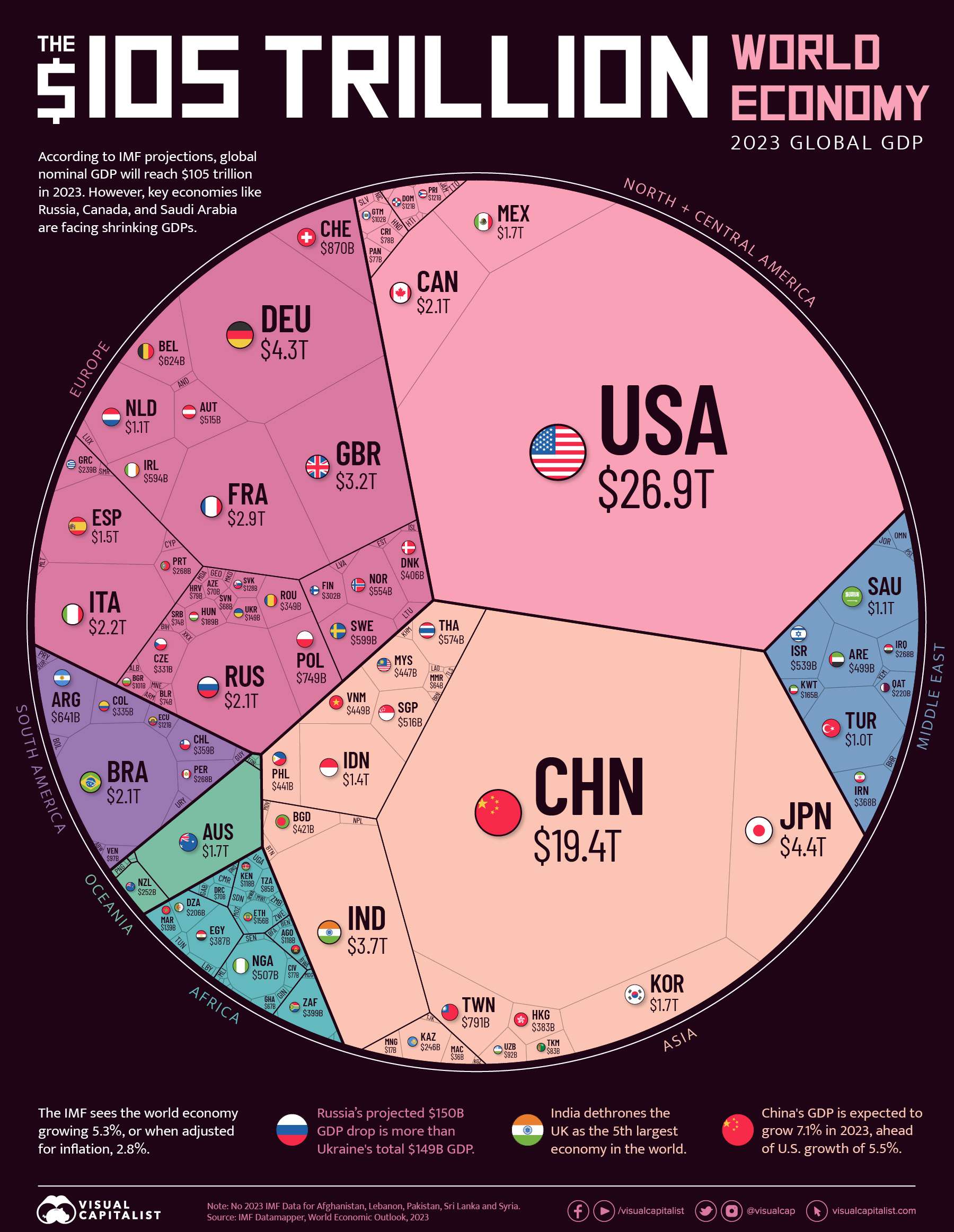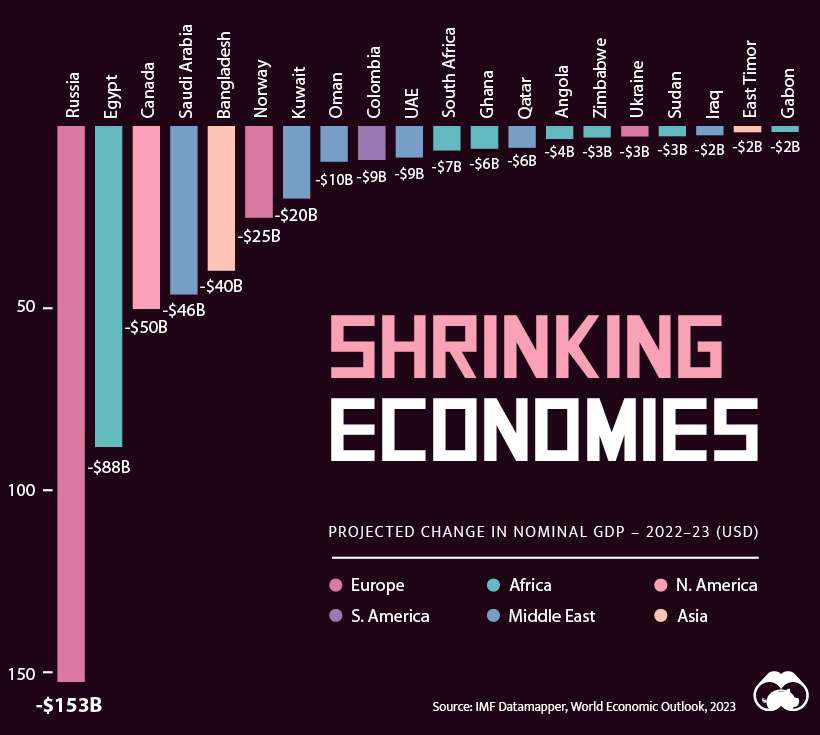According to the latest projections in the 2023 World Economic Outlook report from the International Monetary Fund (IMF), the global economy is anticipated to reach a gross domestic product (GDP) of $105 trillion by the conclusion of 2023. This figure is $5 trillion higher than the previous year’s GDP.
Expressed in nominal terms, this indicates a 5.3% upsurge in the global GDP. When considering inflation-adjusted terms, the increase amounts to 2.8%.

Infographic: https://www.visualcapitalist.com/wp-content/uploads/2023/08/world-economy-2023-full-size.html
Gross Domestic Product (GDP) gauges the overall value of economic production, encompassing goods and services generated by both public and private sectors within a specific timeframe. All figures cited in this article, unless expressly stated, are nominal values and do not factor in the effects of inflation.
The onset of the year was marked by turmoil in the worldwide economy. The collapse of several mid-sized U.S. banks, coupled with ongoing inflation and monetary tightening measures across most nations, significantly rattled financial markets. Nonetheless, select economies have showcased resilience and are projected to achieve growth starting from 2022.
Ranking Countries by Economic Size in 2023
In the year 2023, the United States is anticipated to maintain its position as the largest economy, boasting a projected GDP of $26.9 trillion. This remarkable figure surpasses the combined GDPs of 174 nations positioned within the range of rankings from Indonesia (17th) to Tuvalu (191st).
China retains its steadfast hold on the second place, foreseen to achieve a GDP of $19.4 trillion in 2023. The majority of the top five economies are expected to remain entrenched in their positions from 2022, barring one significant exception.
India’s trajectory is one of ascension, as it is projected to surpass the United Kingdom and claim the fifth spot in the economic hierarchy, buoyed by an anticipated 2023 GDP of $3.7 trillion.
Now, let’s delve into the most robust economies within each global region:
- Africa: Nigeria ($506.6 billion)
- Asia: China ($19.4 trillion)
- Europe: Germany ($4.3 trillion)
- Middle East: Saudi Arabia ($1.1 trillion)
- North & Central America: United States ($26.9 trillion)
- Oceania: Australia ($1.7 trillion)
- South America: Brazil ($2.1 trillion)
Ranked: Economies That Are Contracting in 2023
A total of 29 economies are forecasted to diminish in size compared to their 2022 figures, resulting in an aggregate loss of nearly $500 billion in output.

Russia is poised to experience the most substantial decline, facing an anticipated contraction of $150 billion within the current year. This amount equates to approximately one-third of the collective decline witnessed across all 29 countries grappling with shrinking economies.
Contributing to this contraction, Egypt (-$88 billion) and Canada (-$50 billion) jointly account for another one-third of the total lost output.
In the case of Egypt, the downturn can be partly attributed to the devaluation of its currency, the Egyptian pound, which has experienced a significant drop in value against the U.S. dollar, amounting to around 50% since mid-2022.
Both Russia and Canada, being prominent global oil producers, have encountered the adverse effects of declining oil prices since 2022. Adding to Russia’s predicament, the nation has been compelled to sell oil at a substantial discount due to Western sanctions.
The inclusion of Saudi Arabia, Norway, Kuwait, and Oman in the roster of the ten most considerable GDP contractions further underscores the potential repercussions for economies reliant on oil production, as per the IMF’s projections.
More recently, attempts to elevate prices have involved supply reductions by producers. Nevertheless, persistent apprehensions regarding sluggish global oil demand, particularly emanating from a subdued Chinese economy – the world’s second-largest consumer of oil – have prevented oil prices from surpassing the levels observed in 2022.
What Is the Source of This Data?
Origin: The data is derived from the Datamapper provided by the International Monetary Fund, utilizing forecasts outlined in the April 2023 World Economic Outlook report.
Important to Note: Projections for Afghanistan, Lebanon, Pakistan, Sri Lanka, and Syria are absent from the IMF’s database. Additionally, all figures referenced in the article are nominal GDP values and rates unless expressly indicated otherwise.
ကြော်ညာ တွေဆိုတာ အောက် ပြတဲ့ ဟာတွေဖြစ်တယ်။ ကလစ်ပြီး သူတို့ website မှာ အနဲဆုံး ၁ minute လောက်နေပေးပါ
ကြော်ညာ 2
++++++++++++++
